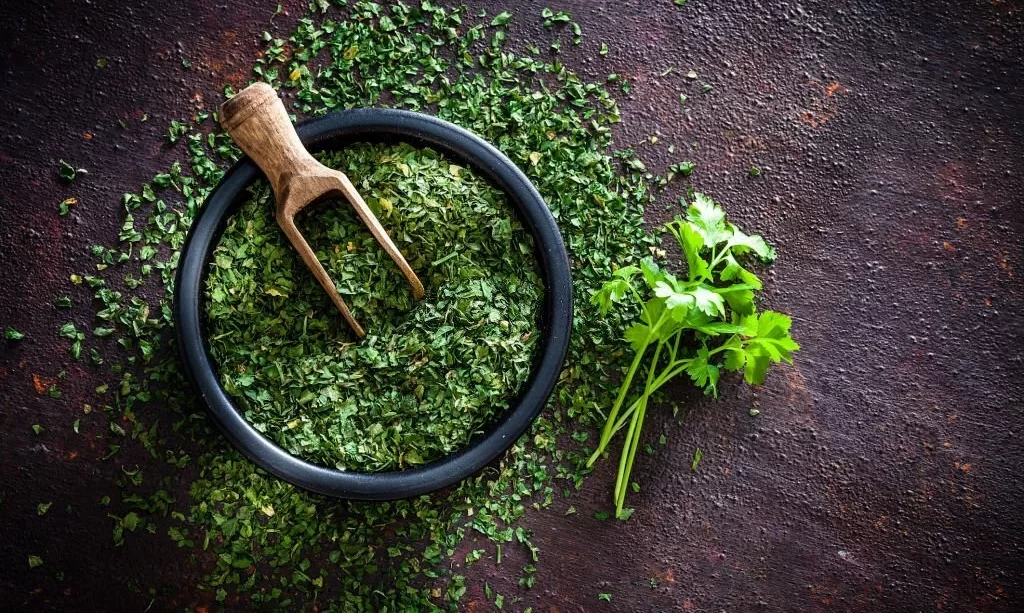Parsley, with its vibrant green leaves and fresh, aromatic flavor, is a versatile herb that elevates the taste of numerous dishes. However, to enjoy its delightful flavor year-round, it’s essential to know how to preserve it effectively. Drying parsley is a simple yet highly effective method for keeping this herb readily available in your kitchen. In this step-by-step guide, we’ll focus on one of the quickest and most efficient ways to dry parsley: using your oven. By following these instructions, you’ll be able to enjoy the rich taste and aroma of parsley in your culinary creations long after the growing season has ended. Let’s begin with the first crucial step: preparing fresh parsley.
- Two bunches of fresh parsley
- Locally grown produce selected by our personal food shoppers.
- Selections vary according to the season and availability.
- Farm-fresh products sourced directly from your local farms and farmers market.
- Eat healthy; support the local economy and the environment.
Preparing Fresh Parsley
Before you can embark on the journey of drying parsley in your oven, it’s crucial to start with fresh parsley and prepare it correctly. Here’s what you need to do:
- Harvest or Purchase Fresh Parsley: You have two options for acquiring fresh parsley. You can either harvest it from your own herb garden, ensuring it’s at the peak of freshness, or purchase it from a local market. When choosing parsley at the store, look for bunches with vibrant green leaves and minimal wilting.
- Inspect and Wash: Once you have your fresh parsley, it’s time to inspect it closely. Check for any damaged, discolored, or wilted leaves, and remove them. This ensures that you’re working with the best quality parsley.
- Gently Pat Dry: After inspecting the parsley, gently pat it dry with a clean kitchen towel or paper towels. You want to remove any excess moisture on the leaves, as this will help speed up the drying process and prevent any potential mold growth.
- Separate Leaves from Stems: To prepare the parsley for drying, separate the leaves from the stems. While parsley stems are edible and can be used in cooking, they take longer to dry than the leaves. For drying purposes, it’s best to focus on the leaves. Simply pinch the stems near the base of each leaf and slide your fingers upward to remove the leaves.
With your fresh parsley carefully inspected, washed, and separated, you’re now ready to move on to the next steps of the drying process, which will ensure that your parsley retains its delightful flavor and aroma.
Prepping Parsley for Drying
Now that your fresh parsley is prepared, it’s time to get it ready for the oven-drying process. Here’s how to do it:
- Spread Leaves Evenly: Take the parsley leaves you’ve separated and arrange them evenly in a single layer on a clean kitchen towel or paper towels. This additional step ensures that any remaining moisture is absorbed, aiding in the drying process.
- Remove Excess Stems: While you’ve separated the majority of the stems in Section 1, take a moment to check for any small stems or stubborn ones that may still be attached to the leaves. Removing these ensures that the drying process is as efficient as possible.
- Ensure Proper Spacing: Lay out the parsley leaves on a clean, dry surface. Avoid overcrowding the leaves, as this can hinder the drying process. If you have a large quantity of parsley, you may need to work in batches.
Oven Drying Method
Drying parsley in the oven is a quick and efficient process that preserves its flavor and aroma. Follow these steps to get started:
- Preheat the Oven: Begin by preheating your oven to a low temperature, typically around 150°F (65°C). The low temperature ensures that the parsley dries slowly, preserving its flavor.
- Prepare Baking Sheets: Line one or more baking sheets with parchment paper or use silicone baking mats to prevent sticking and make cleanup easier.
- Arrange Parsley Leaves: Place the prepared parsley leaves in a single layer on the baking sheet(s). Ensure that the leaves are not overlapping to allow for proper airflow.
- Oven Door Ajar: To facilitate the moisture escape during drying, leave the oven door slightly ajar. This prevents the buildup of humidity inside the oven.
- Drying Time: Let the parsley dry in the oven for approximately 1 to 2 hours. The exact time may vary depending on your oven’s temperature accuracy, the quantity of parsley, and the humidity level in your kitchen.
Checking for Dryness
Knowing when your parsley is adequately dried is crucial for preserving its quality. Here’s how to check for dryness:
- Cooling: After the suggested drying time, remove a few parsley leaves from the oven and let them cool to room temperature. This step prevents any residual heat from affecting your judgment.
- Crumble Test: Take a cooled parsley leaf and gently crumble it between your fingers. If it crumbles easily into small pieces and has lost its moisture, it’s dried to perfection.
- Visual Inspection: Additionally, visually inspect the parsley leaves. They should appear crisp, brittle, and dry without any remaining moisture. If you find any leaves that still appear moist or pliable, return them to the oven for further drying.
Once your parsley leaves have passed the crumble test and are visibly dry, they are ready to be cooled, stored, and used in your favorite dishes. Dried parsley will retain its vibrant flavor, allowing you to enjoy the essence of fresh parsley even when it’s out of season.
Cooling and Storing Dried Parsley
Properly cooling and storing your dried parsley is crucial to maintain its flavor and quality. Follow these steps for the final stages of preserving your aromatic herb:
- Cooling: Once your parsley leaves have passed the crumble test and are thoroughly dried, remove the baking sheet(s) from the oven. Allow the dried parsley to cool completely at room temperature. This cooling process prevents any residual heat from condensing moisture and affecting the stored parsley.
- Storage Container: Choose an airtight container for storing your dried parsley. A glass jar with a tight-fitting lid is an excellent option. Ensure that the container is clean and thoroughly dry before use.
- Label and Date: Label the container with the date of drying to keep track of its freshness. Additionally, consider labeling it as “Dried Parsley” to easily identify its contents in your pantry.
- Storage Location: Store the airtight container in a cool, dark, and dry place. Direct sunlight, moisture, and fluctuations in temperature can degrade the quality of dried herbs. A pantry or cupboard away from the stove or sink is an ideal storage location.
- Avoid Crushing: Handle the dried parsley gently to avoid crushing the delicate leaves. Dried herbs are fragile, and maintaining their integrity ensures that they retain their aromatic qualities.
- Splatter-resistant microwaving with built-in vents under latches; resists stains and odors for long-lasting use
- Stacks perfectly to one another to save space and stay organized in the pantry or fridge
- International products have separate terms, are sold from abroad and may differ from local products, including fit, age ratings, and language of product, labeling or instructions
- Safe for the dishwasher, microwave and freezer
Conclusion
Drying parsley in the oven is a rewarding and practical way to preserve the vibrant flavor and aroma of this versatile herb. By following the steps outlined in this guide, you’ve learned how to go from fresh parsley to beautifully dried leaves ready to enhance your culinary creations.
The convenience of having dried parsley at your fingertips means you can enjoy its delightful flavor year-round, whether you’re seasoning soups, stews, sauces, or your favorite dishes. Remember that properly stored dried parsley can retain its quality for several months, making it a valuable addition to your kitchen pantry.
With your knowledge of how to dry and store parsley effectively, you can savor the essence of this herb whenever you desire, even when the garden has gone dormant or fresh parsley is out of season.






